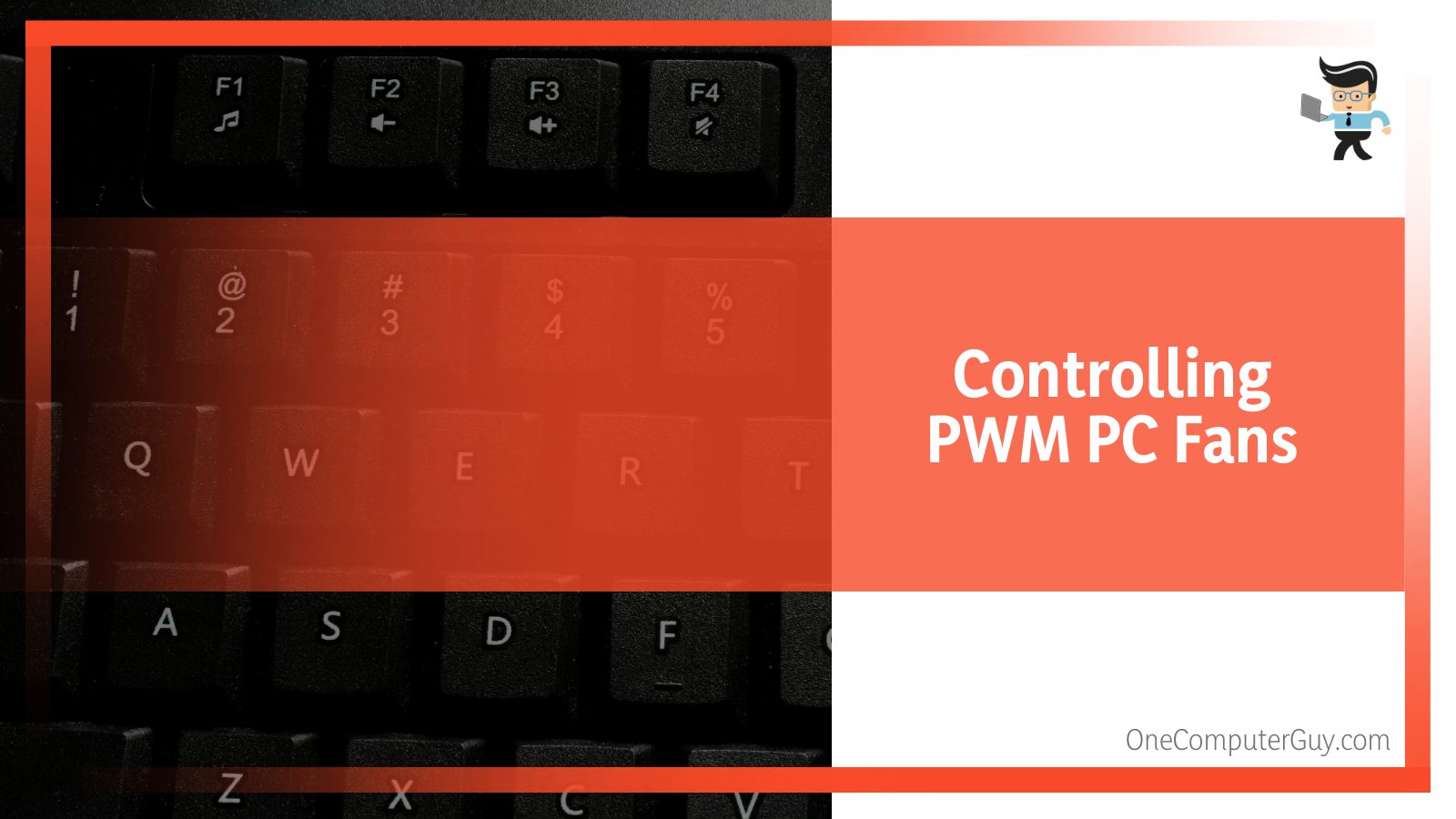The PWM cable is a cable attached to case fans. It should be plugged directly into your PC’s motherboard. If you’re having a hard time plugging your PWM cable to motherboard, then there’s a chance that you’re plugging it into the wrong header.
Contents
Join our experts as we explore what PWM cables are, where they’re supposed to be plugged into, and how to install them on your motherboard.
What Is PWM Cable?
PWM cable is a small cable that helps control a fan’s flow and speed. This cable is used in devices that need to change their flow or speed.
This technology works by separating the electric signals into different parts, allowing the device that’s using the cable to govern the average voltage it receives into its load.
Where Do Plug PWM Cable?
As we noted earlier, you connect PWM directly to your motherboard. Since PWMs come with a 4-pin header, you’ll need a four-pin connector on your motherboard to plug in your 4-pin PWM cable.
Many users are unable to install their fans simply because they are making the mistake of trying to fit the four-pin header of the PWM cable into the three-pin connector on their motherboard.
Where Can You Install PWM Fans?
You can install your PWM computer fans on your GPU, CPU, and casing. You can also find PWM water cooling pumps on the market, but keep in mind that these pumps are very power-hungry.
Therefore, make sure to identify the type of fans you’ve purchased before trying to install them on your motherboard.
You can connect your fan to your computer’s motherboard using two different types of cable. These cables are:
– The Three-pin Cable
These cables are designed with just three pins. You can connect them to your motherboard’s connector, whether the connector has four pins or three pins.
Each cable does the following tasks:
- The black layer provides a ground connection.
- The yellow layer provides voltage supply, which is often 12 volts.
- The green layer provides the RPM signal, otherwise known as the tachometer.
– The Four-pin Cable
The four-pin cables come with an extra cable for PWM. These cables can be connected to both the three-pin and four-pin connectors on a motherboard.
However, if they are plugged into a three-pin connector, the PWM function won’t work as the system will only recognize the first three pins.
Therefore, you won’t be able to control your fans since the PWM will be inactive. The four-pin PWM works as follows:
- The black layer provides a ground connection.
- The yellow layer provides voltage supply, which is often 12 volts.
- The green layer provides an RPM signal, otherwise known as the tachometer.
- The blue layer provides a PWM signal.
Using PWM PC Fans Without PWM
You can safely connect your PWM fan to your motherboard’s three-pin connector by removing the PWM cable. As we’ve explained above, the cable acts as an on/off switch that controls your fan for when it’s needed and when it’s not. It also controls your fan’s speed. Regular fans don’t have this switch, so they tend to run at maximum speed when they’re working.

Removing the PWM and connecting your fan to the three-pin connector on your motherboard will turn your fan into a regular case fan.
You won’t be able to turn it off or control its speed. Also, regular fans tend to end their life cycle once the voltage drops below 5V.
On the other hand, fans with PWM can have their speed reduced down to 300 to 600RPM, making your PC as noiseless as possible without dying.
Some fans can even be turned off completely and still work properly when the need to dispel heat arises.
Installing Fans With PWM On Four-Pin Motherboards
Many of the motherboards in today’s market often feature four-pin connectors, so you can just plug your PWM fan straight into the PWM cable pinout. Most motherboards tend to come with at least two fan headers.
However, there are MOBOs like the B450m that feature up to four different headers, making it confusing for users to know where to plug their fans.
When installing your fan in a MOBO like that, you should look out for one of these tags on the pin headers in your motherboard:
- PWR_FAN stands for power fan.
- SYS_FAN refers to your system fan.
- EXT_FAN means the extension fan.
- CHA_FAN stands for chassis fan.
If you can’t find any of these tags on your MOBO, check the bottom-left section of your motherboard. There should be a header where you can plug in your fan.
Each of the connectors on your motherboard will feature two tabs that resemble a bump.
One of these tabs would be at the beginning of the header, while the other will be at the end of it. Make sure your fan’s header lines up correctly with the connector on your motherboard.
Gently push the fan’s header into the connector until it sits securely on your motherboard.
We recommend that you plug your fan’s header into the nearest connector on your motherboard so you can have excellent cable management.
Installing PWM Fan on Motherboards Without Four-Pin Connectors
You can still install your fan on your motherboard even if you don’t have four-pin connectors on your MOBO.
Three of the headers in your fan’s four-pin headers can be connected to your motherboard’s three-pin connectors. However, you’ll lose the ability to control your fan’s speed and activity.
If you’re keen on controlling it, you can use some Y-splitters to carry out a workaround. However, you may put your motherboard at risk using this method, therefore we do not recommend it.
– Controlling PWM PC Fans Through BIOS

After installing your PWM PC fans correctly into your MOBO’s four-pin connector, you’ll be able to control the fans using your motherboard’s BIOS. All you have to do is follow the steps listed below:
- Restart your computer and press F2 at the bootup screen to enter the “System Utility” screen.
- If F2 doesn’t work, you can try using the delete or F1 buttons.
- Once you’re on your BIOS screen, select “Fan Info” from the list of options.
- You’ll be greeted with two different fan options, including “System Fan” and “CPU Fan.”
- Select the CPU Fan settings option and activate the “Smart Fan Mode.”
- Next, set the speed of your fan to your preferred choice.
- Once that is done, turn on the “CPU Fan Fail and Warning Control” so you can be notified if any of your fans become inactive.
We recommend working your fan speed with your CPU’s temperature.
You can allow your fan to run at 70 percent when your CPU’s temperature rises up to 50 degrees Celsius; 85 percent if the temperature becomes higher but lower than 60 degrees Celsius, and 100 percent if the temperature rises up to 70 degrees Celsius and above.
FAQ
– What is the Difference Between PWM and DC?
There are two main types of computer fans — PWM and DC fans. DC fans or direct current feature three pins, and they are powered by the motherboard’s header pins or regulated direct current supply.
The three pins featured on DC fans are a signal pin, a supply pin, and a ground pin.
PWM PC fans are similar to DC fans, but they come with four-pin headers instead of three. These header pins comprise the three found in DC fans as well as the PWM pin.
The fourth pin, which is the PWM pin, uses the cable to send a signal to the fan’s motor.
This signal is what controls the speed and flow of the fan. It’s like a switch that turns on the fan when needed and turns it off when it’s not.
You’ll be able to adjust the fan’s power, raising it from zero to 100 percent according to the motor’s rotation.
Note that PWM computer fans need up to 12 volts of power to run constantly. For this reason, you need to make sure that you only use one fan in your setup.
And if you’d like to use more than one fan, make sure that don’t use more than two and both fans should be connected via a Y-splitter.
– What Is a PWM Header on a Motherboard?
The PWM header is the four-pin connector on your motherboard. There are usually up to two connectors on your motherboard.
– Do I Need To Plug in PWM Cable?
Yes, if you wish to control your fans. But if you don’t intend to control your fans, then there’s no reason to.
– Do All Motherboards Support PWM
No, not all motherboards support PWM. While most modern motherboards come with four-pin connectors that work well with PWM, there are motherboards that come with three-pin headers, making it impossible for them to work with PWM.
Conclusion
Now, you know what PWM is, how to connect your fans with PWM, and whether or not they’ll work with your motherboard.
Let’s sum up everything we’ve talked about so you have all you need to work on your PWMs:
- You can only use the PWM function i.e., controlling your fan if your motherboard has a four-pin connector.
- If your fans with PWM are plugged into a three-pin connector, the fans will work, but you won’t be able to control them.
- PWM allows you to control your fan’s speed and activity.
- You can control fans that support PWM via your motherboard’s BIOS.
With that said, you now have all you need to install and control your PWM PC fans.
Make sure to turn on CPU Fan Fail and Warning control in your BIOS so you can get a warning sign when your fan isn’t working properly or when it dies.








